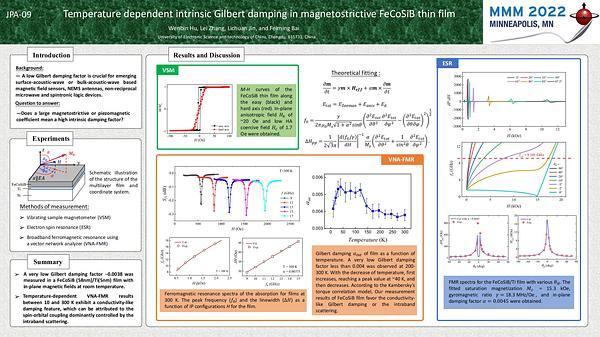Would you like to see your presentation here, made available to a global audience of researchers?
Add your own presentation or have us affordably record your next conference.
Studies of amorphous magnetic wires have become a traditional topic of applied magnetism owing to excellent magnetic properties and the development of prospective applications 1,2. Taylor-Ulitovsky fabrication technique provides the broadest microwires diameters range together with improved corrosion, mechanical properties and biocompatibility related to the presence of the glass-coating 2,3. However, the latter is a source of additional magnetoelastic anisotropy, Kme, which is one of the most important factors determining the magnetic properties of the amorphous materials.
One effective method for evaluation of magnetic anisotropy in magnetic wires is the ferromagnetic resonance, FMR 2. Additionally, FMR allows the evaluation of several material properties as saturation magnetization, g-factor, damping parameter, etc. 2,4.
We report experimental results of FMR and magnetic properties of various Fe and Co-based glass-coated microwires. We observed that the coercivity, Hc, of Co-Fe-rich microwires depends on the chemical composition: the highest Hc is observed for the microwire with highest Fe content. Such dependence must be attributed to Fe content influence on the magnetostriction coefficient, λs 3.
FMR spectra presents considerable dependence on resonance field, Hr, frequency, f (Fig.1) and Kme 4. In all studied microwires Hr increases with f. Hr is also affected by the microwire diameter: the FMR spectra for microwires with similar chemical composition, but diameter almost an order of magnitude different are shown in Fig.2. On the other hand, even for the same λs (mostly determined by the chemical composition), Kme is affected by the value of the internal stresses, σi, that it is mostly determined by the ratio ρ, between metallic nucleus diameter, d, and total microwire diameter, D 3,4. Therefore, the difference observed in FMR spectra must be attributed not only to different d, but also to the difference in σi. Additionally, in thin enough microwires the interface layer between the glass-coating and metallic nucleus can affect the FMR behavior 3.
References:
1 M. Knobel, M. Vázquez, L. Kraus, Giant Magnetoimpedance, in Handbook of Magnetic Materials, Elsevier, Vol. 15, p497 (2003).
2 K. Mohri, et al., IEEE Trans. Magn., Mag-26, p.1789 (1990).
3 A. Zhukov et al., J. Alloys Compd., Vol. 814, p. 152225 (2020), doi:10.1016/j.jallcom.2019.1522250925-8388.
4 L. Kraus, Ferromagnetic resonance in individual wires: From micro- to nanowires, in Magnetic Nano- and Microwires (ed. M. Vázquez), Elsevier, ch. 15 (2015).

Fig.1. FMR spectra of Fe79B8Si10C3 microwire (d=19.2 μm).

Fig.2. FMR spectra of Fe74B13Si11C2 (d=19.2 μm) and Co2.25Fe72.75Si15B10 (d=2 μm) microwires.
